Computer vision has emerged as a major development in the sports industry, transforming the sector in a variety of ways. This involves tracking players’ body language, movements, and behaviors for signs of injury risk.
The majority of sports include fast and rapid movement that is difficult to track and detect with the naked eye. The first and most important use of machine learning in sports is the capacity to follow this motion.
Computer vision uses artificial intelligence algorithms to read images from cameras. This helps in the tracking of movements, creating new training methods, making quick decisions during matches, and much more.
As a result, it makes a wide range of useful new tools available to teams, coaches, sports analytics experts, players, scouts, and fans.
Let’s take a closer look at a few common applications of computer vision in sports.
Application of Using Computer Vision in Sports
Sports use computer vision in different kinds of ways, such as:
- Player Monitoring
- Match Predictions
- Preventing Injuries
- Referee Assistance
- Boosting the Fan Experience
Player Monitoring
Coaches could help their teams perform better by using player tracking, which is the process of determining a player’s position at any given time. They can quickly examine the team’s overall configuration and the movements of each individual player on the pitch via tracking.
For example, recognizing the pose of the players as shown below helps players identify areas for improvement, while coaches can better track players’ performance.
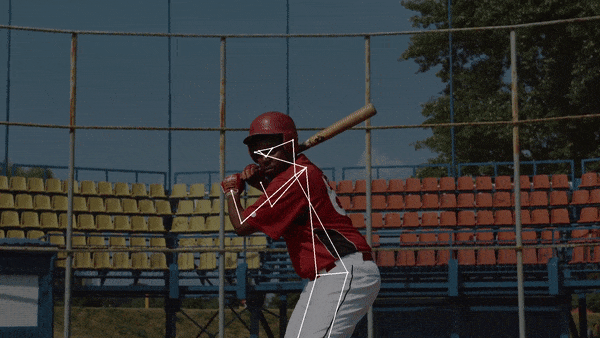
Player’s Pose Tracking (Source)
Match Predictions
To increase their chances of winning large sums of money, sports bettors have always tried to analyze data to gain more insight and predict the results of upcoming games.
Furthermore, machine learning algorithms can be used to predict the winner of a sporting event by tracking the motions of the participants. A computer vision system can be trained to predict the winner of a match by analyzing the data it collects.
For example, the red-marked areas in the following image indicate strong times as indicated by the predicted scores. An extremely anxious time in the game is depicted by the first two red bars, which show a near-goal scenario. At the end, during the third intense red bar, the team finally scored a goal.
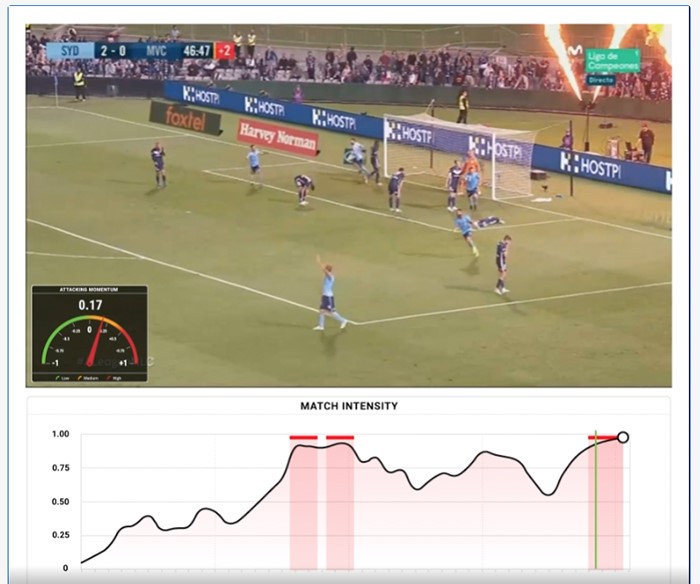
Predicting soccer goals in near real time with computer vision (Source)
Preventing Injuries
Computer vision methods like obtaining features, posture estimation, and motion detection can identify unsafe actions that could result in injuries.
To prevent injuries, trainers and doctors can create individual fitness and training programs with the help of analyzed data.
For instance, players can be guided and corrected through recommended exercises using posture tracking and analysis.
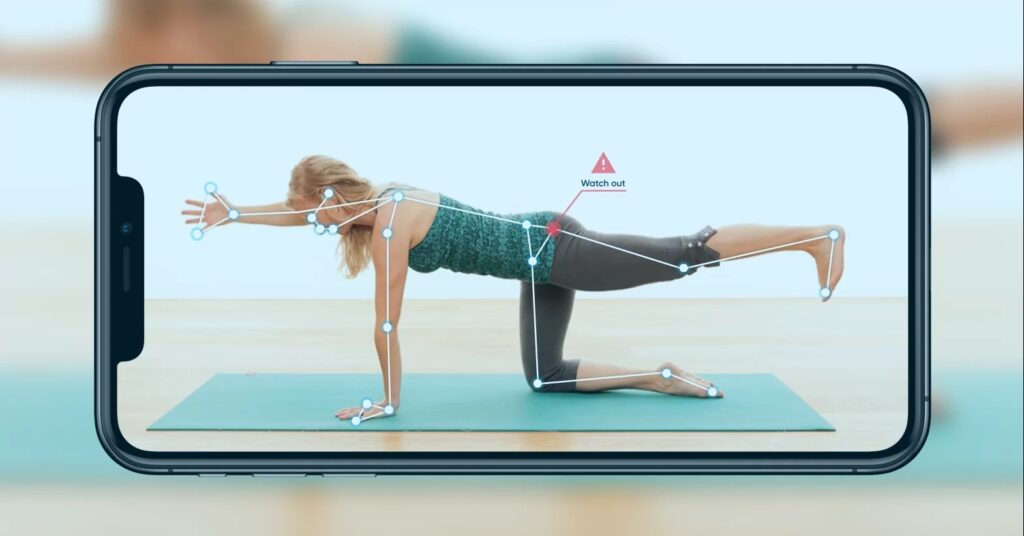
Posture tracking and analysis (Source)
Referee Assistance
AI referees can minimize human error by using computer vision and machine learning to make precise calls in real time.
For instance, the Hawk-Eye system is a computer system used in tennis and cricket that tracks the ball’s path and assists in determining whether a ball is fair or foul.
The accuracy of this method is significantly higher than that of the human eye, within a few millimeters.
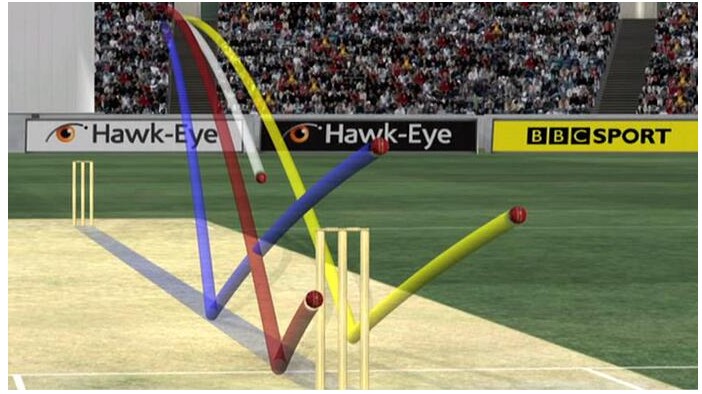
Hawk-Eye technology tracks the ball path (Source)
Boosting the Fan Experience
The development of augmented reality (AR) features that let fans watch sports from the athletes’ point of view or virtually enter stadiums from the comfort of their own homes is made possible by computer vision.
For instance, ‘Catch Me Up,’ a new feature that improves the Wimbledon digital experience, uses IBM’s Watsonx AI and analytics platform to offer match analysis, daily summaries and player stories that are customized to each fan’s choices.
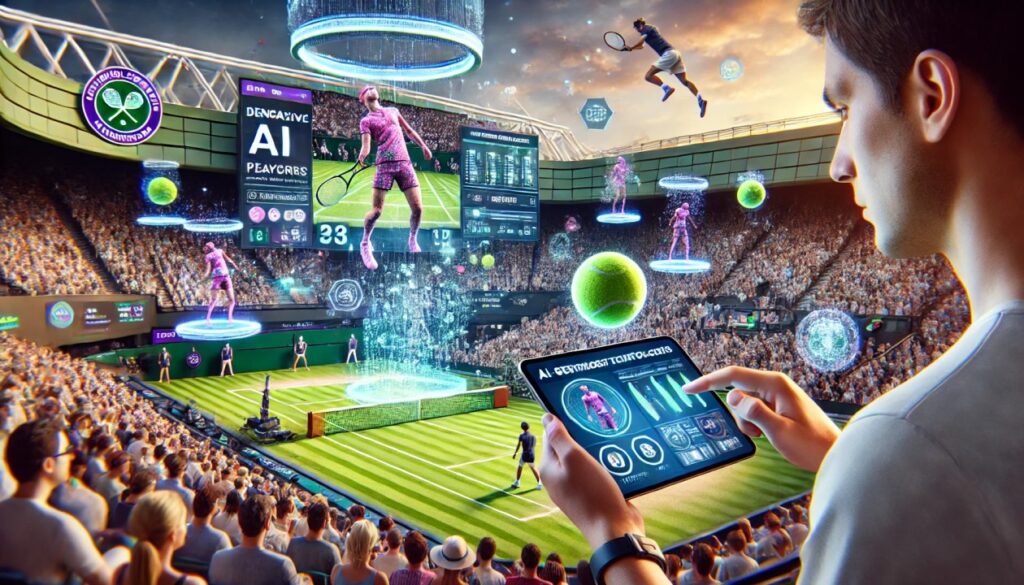
A New Era of Personalized Fan Experiences (Source)
Enhancing Sports Analytics with Computer Vision
Let’s examine the various advantages of applying computer vision to sports analytics:
- Accurate information: In sports analysis, computer vision is a great method for getting current, accurate data when field video recording is lacking.
- Automated umpiring: Systems for automated umpiring can be built using ball tracking data. This reduces human error, improves justice, and lessens unfair punishments.
- Cost-effective: AR removes the need for expensive, physical training tools.
- Performance improvement: Athletes’ movement, such as a basketball player’s throwing style, can be recorded and examined by computer vision. This can improve their performance and develop their techniques.
- Advanced tracking and analysis: Improved tracking and analysis of players during practice and competition is made possible by computer vision, which helps to create and improve game planning.
- Keeping fans engaged: Smart stadiums are currently using augmented reality (AR) to provide engaging experiences for fans, such as projecting live data and highlights on the field during the game.
The State of the AI Sports Market
As more sports organizations use AI technologies for better fan experiences and gain a competitive edge, the market for AI in sports is growing quickly.
According to the data provided below, the size of the global AI in sports market is estimated to increase from USD 2.6 billion in 2023 to USD 36.7 billion by 2033, with a compound annual growth rate (CAGR) of 30.3% from 2024 to 2033.
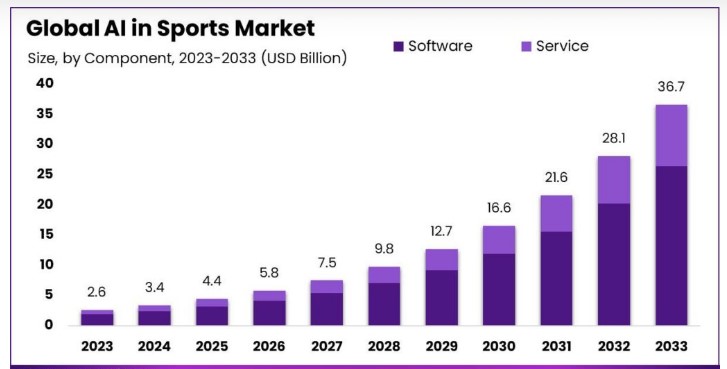
Challenges of AI in the Sports Market
Let’s review few challenges that the sports industry faces with AI, such as:
- Protection and privacy of data: There is a greater chance of data leakage and misuse because it comes from a variety of global sources.
- Affects fairness scale: Because of the increasing bias of commentators, the fairness scale in sports has suffered. This may result in unfair results when it comes to recruiting, player evaluation, and game strategy.
- Absence of qualified experts: The use of artificial intelligence in sports is clearly being held back globally by a growing lack of advanced skills and a rising ignorance of digital technology.
What’s Next For Computer Vision In Sports
The following are expected improvements in sports AI in the future:
- AI will get better at predicting player performance, accurate game results, and illness.
- It will be able to identify the biases and provide outcomes that are entirely fair.
- Viewers will be able to select their preferred commentary style and receive interesting analytics through AI-powered broadcasting and commentary.
- An athlete’s brain activity will be analyzed by AI-powered devices to help them improve their mental health and performance.
- Artificial intelligence (AI)-powered facial recognition software can identify when a person may get angry due to mental stress or make mistakes because they are playing too hard.
Implementation of AR and VR Technologies
Teams and athletes can also use AR and VR for performance analysis and training. As an example, players can practice and improve their skills in a safe setting by using virtual reality (VR) to mimic game scenarios.
Additionally, it opens up opportunities for ads and sponsors. For instance, advertisers can make virtual ads that appear on the field during a game using AR technology.
Moreover, it makes for a more engaging watching experience for spectators and improves stadium design. The most recent player profiles, 3D game rewinds, live discussion with other fans, and virtual stadium exploration are all available to fans.
Computer Vision and AI Startups Shaping the Future of Sports
Computer vision and AI are being used by creative businesses to improve sports participation, training, and engagement. Let’s review some of the more notable contributors.
AiSport
AiSport, a US-based company, is developing a fitness platform that will allow users to receive real-time feedback on their workout methods from the comfort of their smartphones. The platform will look at and correct users’ posture during exercise to improve performance and avoid injuries.
Anna Stepura and Dariia Hordiiuk, two Ukrainian women and lifelong sports fans, co-founded AiSport. Silicon Valley is still working on the AiSports platform today. The business has $200K in total funding. On May 12, 2022, AiSport closed their most recent round of investment, which was an angel round.
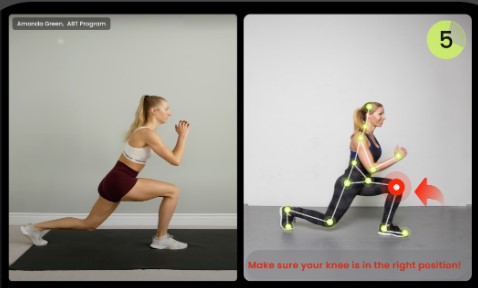
AiSport providing workout technique (Source)
Hawk-Eye Innovations
Hawk-Eye Innovations, a leading UK-based company and member of the Sony Group, focused on applying computer vision to sports. In many different sports, such as tennis, cricket, and soccer, it provides accurate and instant tracking, analytics, and technical support.
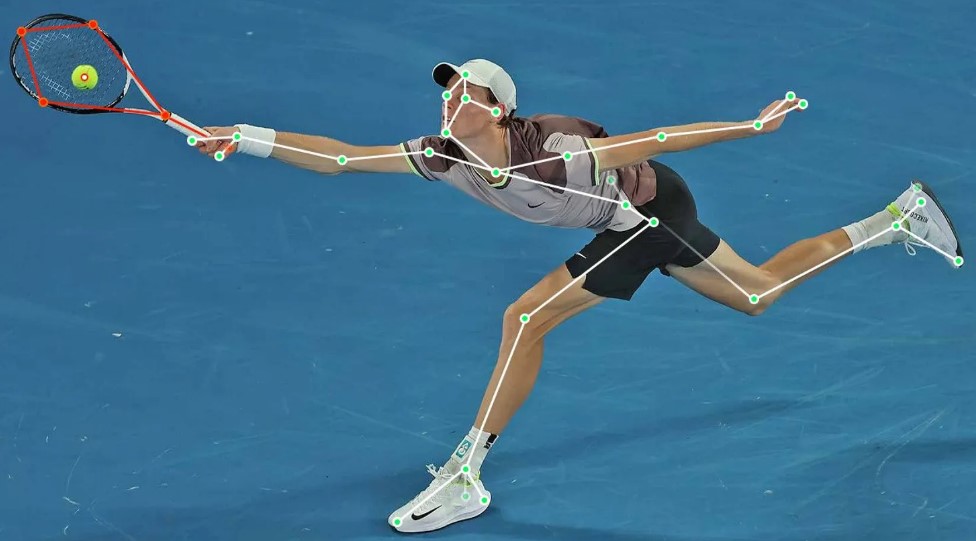
Player and ball tracking tracking using Hawk-Eye Innovations (Source)
They are now well-known throughout the world and play a crucial role in sporting events in over 90 nations. Over the course of two rounds, Hawk-Eye Innovations has raised $748K in investment. June 1, 2001, was the date of its first investment round.
Ludimos
A cricket coaching app on smartphones called Ludimos is revolutionizing the sport. Madan Rajagopal, an Indian cricket fan in the Netherlands, founded Ludimos because he was unhappy with the lack of resources to track players’ development and the varying training advice he was receiving.
With the use of the app’s multi-angle video analysis feature, player skills may be carefully reviewed from different points of view. The software provides a data-driven understanding of player performance and specializes at tracking balls and bats.
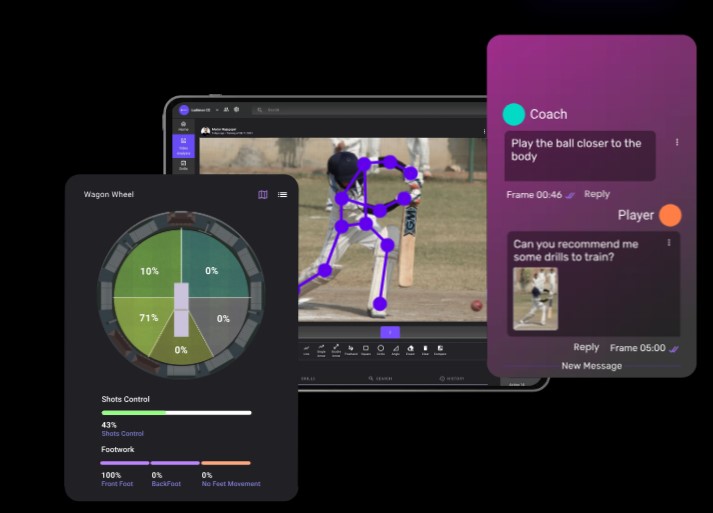
Analyze cricket using Ludimos (Source)
On February 2, 2023, it raised an unknown sum in its most recent investment round, which was a seed round. In its most recent round, Dutch Sport Tech Fund led one investor.
Computer vision in sports brings up new possibilities for innovation in the future, making sports more competitive, engaging, and safe for all participants.
As the sports industry develops and grows, we could see considerably increased fan engagement, smarter training methods, and more advanced analysis.



